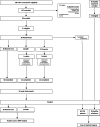Interrelationship between micronutrients and cardiovascular structure and function in type 2 diabetes
- PMID: 34733500
- PMCID: PMC8532075
- DOI: 10.1017/jns.2021.82
Interrelationship between micronutrients and cardiovascular structure and function in type 2 diabetes
Abstract
Micronutrients are important for normal cardiovascular function. They may play a role in the increased risk of cardiovascular disease observed in people with type 2 diabetes (T2D) and T2D-related heart failure. The aims of this study were to (1) examine micronutrient status in people with T2D v. healthy controls; (2) assess any changes following a nutritionally complete meal replacement plan (MRP) compared with routine care; (3) determine if any changes were associated with changes in cardiovascular structure/function. This was a secondary analysis of data from a prospective, randomised, open-label, blinded end-point trial of people with T2D, with a nested case-control [NCT02590822]. Anthropometrics, cardiac resonance imaging and fasting blood samples (to quantify vitamins B1, B6, B12, D and C; and iron and ferritin) were collected at baseline and 12 weeks following the MRP or routine care. Comparative data in healthy controls were collected at baseline. A total of eighty-three people with T2D and thirty-six healthy controls were compared at baseline; all had micronutrient status within reference ranges. Vitamin B1 was higher (148⋅9 v. 131⋅7; P 0⋅01) and B6 lower (37⋅3 v. 52⋅9; P 0⋅01) in T2D v. controls. All thirty participants randomised to routine care and twenty-four to the MRP completed the study. There was an increase in vitamins B1, B6, D and C following the MRP, which were not associated with changes in cardiovascular structure/function. In conclusion, changes in micronutrient status following the MRP were not independently associated with improvements in cardiovascular structure/function in people with T2D.
Keywords: BMI, body mass index; CMR; CMR, cardiac magnetic resonance imaging; CVD, cardiovascular disease; Cardiovascular function; EF, ejection fraction; HF, heart failure; LV, left ventricular; Low calorie; Low-energy meal replacement plan; MRP, meal replacement plan; Micronutrients; PLP, pyridoxal 5-phosphate; RCT, randomised control trial; T2D, type 2 diabetes; Type 2 diabetes.
© The Author(s) 2021.
Figures


References
-
- Diabetes UK (2019) Number of people with diabetes reaches 4.7 million. https://www.diabetes.org.uk/about_us/news/new-stats-people-living-with-d... (accessed April 2020).
-
- Dunlay SM, Givertz MM, Aguilar D, et al. (2019) Type 2 diabetes mellitus and heart failure: a Scientific Statement from the American Heart Association and the Heart Failure Society of America: this statement does not represent an update of the 2017 ACC/AHA/HFSA heart failure guideline update. Circulation 140, e294–e324. - PubMed
-
- Goldberg LR & Jessup M (2006) Stage B heart failure: management of asymptomatic left ventricular systolic dysfunction. Circulation 113, 2851–2860. - PubMed
Publication types
MeSH terms
Substances
Associated data
Grants and funding
LinkOut - more resources
Full Text Sources
Medical
Research Materials
Miscellaneous

